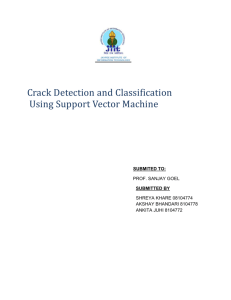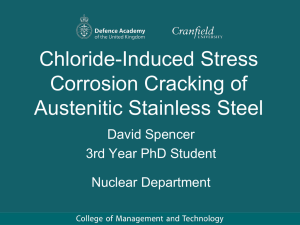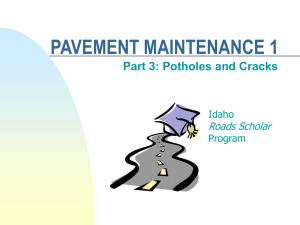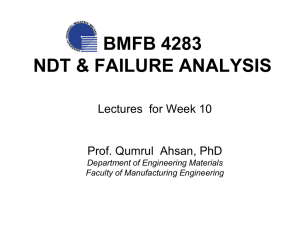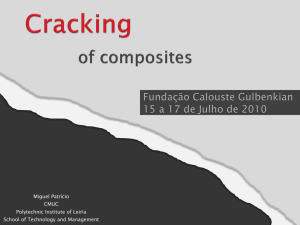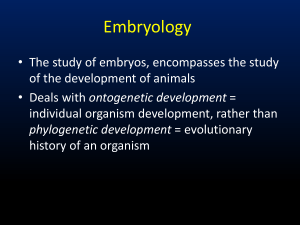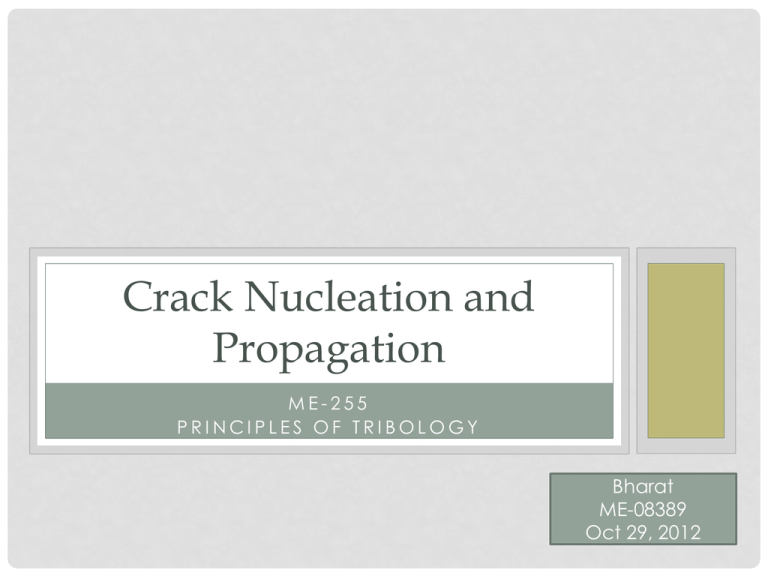
Crack Nucleation and
Propagation
ME-255
PRINCIPLES OF TRIBOLOGY
Bharat
ME-08389
Oct 29, 2012
Organization of Presentation
•
•
•
•
•
•
•
Basic fracture types
Stress temperature curves
Nucleation of Cleavage Cracks
Propagation of Cleavage Cracks
Effect of Grain Boundaries
Effect of State of Stress
Fracture diagram
Basic Fracture Types
Shape of
Original
specimen
Brittle
fracture
Ductile
fracture
Stress Temperature Curve For Crack
Initiation And Propagation
Nucleation of Cleavage Cracks
• Two stages in the formation of Cleavage Crack
• Nucleation (Controlled entirely by local stresses around slip or twin bands)
• Growth (Governed both by the applied stress acting on the solid and local
stresses)
• For Polycrystalline metals
Growth
Growth of crack across
An individual grain
Propagation of a grain size
Cleavage crack through
the complete solid
Nucleation of Cleavage Cracks
Nucleation of Cleavage Cracks
• Metals don’t fracture as a result of pre-existing Griffith cracks.
• Cleavage cracks nucleated by stress concentration
produced by inhomogeneous plastic-deformation.
• Fracture front moves across the specimen discontinuously,
being impeded by the twins that form in front of it.
• Crack has to be continuously renucleated on the far side of
the twins in order to keep on moving.
Nucleation of Cleavage Cracks
• Nucleation Condition
𝜎=
•
•
•
•
•
4𝛾𝐺
𝜋(1 − 𝜐)𝑑
σ- Effective shear stress acting on the dislocations
𝛾- Free surface energy
G- Shear modulus
𝜐- Poisson’s ratio
2d- Length of slip plane containing pile up of edge dislocations
Nucleation of Cleavage Cracks
• Nucleation of a cleavage crack along a plane tilted at an
angle φ to that containing a pile up of edge dislocations:
𝜎=
4𝛾G
𝜋 1−𝜐 d
5 + 2cos𝜑 − 3cos 2 𝜑
4
Nucleation of Cleavage Cracks
• Important to consider the effect of temperature on the critical
resolved shear stress.
• In BCC metals, e.g. iron, the temperature dependence of
critical resolved shear stress for slip is very large.
Regimes of Crack Propagation
• Stage I: crack growth
Average crack growth
< one lattice spacing
• Stage II: crack growth
& fatigue striations:
Paris law application
• Stage III: Fast crack growth:
catastrophic failure!
• Regions I, III – very sensitive
to metallurgical variables,
test conditions
Propagation of Cleavage Cracks
• Two Approaches
• Griffith approach (Energy based)
• Inglis approach (Stress based)
Griffith Approach
Increase in surfaceenergy 4 c
When crack grows
Reduction in elastic energy c 2
2
E
2
Change in energy U 4 c c 2
E
U →
dU
0
dc
U 0
c*
c0
c * critical crack size
Contd…
c
*
2 E
2
• Griffith approach gives,
2 E
f
c*
Propagation of Cleavage Cracks
• Condition for crack propagation
K ≥ Kc
Stress Intensity Factor:
--Depends on load &
geometry.
Fracture Toughness:
--Depends on the material,
temperature, environment &
rate of loading.
• All brittle materials contain a population of small cracks and
flaws that have a variety of sizes, geometries and orientations.
• When the magnitude of a tensile stress at the tip of one of
these flaws exceeds the value of this critical stress, a crack
forms and then propagates, leading to failure.
Propagation of Cleavage Cracks
• K= Y a
• Where, K- Stress intensity factor
• a- length of surface crack or ½ length of internal
crack
• Y- dimensionless parameter
design
Kc
Y a max
Propagation of Cleavage Cracks
• Crack grows incrementally
da
m
K
dN
typ. 1 to 6
~ a
increase in crack length per loading cycle
crack origin
• Failed rotating shaft
-- crack grew even though
Kmax < Kc
-- crack grows faster as
• Δ σ increases
• crack gets longer
• loading freq. increases.
Crack Growth Rate
1.
2.
Initially, growth rate is
small, but increases
with increasing crack
length.
Growth rate increases
with applied stress level
for a given crack
length (a1).
S-N Curves
• A specimen is subjected to stress cycling at a maximum stress
amplitude; the number of cycles to failure is determined.
• This procedure is repeated on other specimens at progressively
decreasing stress amplitudes.
• Data are plotted as stress S versus number N of cycles to failure for
all the specimen.
• Typical S-N behavior: the higher the stress level, the fewer the
number of cycles.
Effect of Grain Boundaries
Effect of State of Stress
• Large tensile stresses and small shear stresses favor cleavage.
σ
σ
σ
σ
Fracture Diagram
References
• Hahn, G.T., Averbach, B. L., Owen, W. S., and
Cohen, M., ‘Fracture’
• Biggs, W. D. and Pratt, P. L., ‘Deformation and
fracture of alpha-iron at low temperatures’
• Robert E. Reed-Hill, ‘Principles of Physical
Metallurgy’
• E. Smith, ‘Nucleation of Cleavage Cracks in Solids –
Fracture at Screw Dislocation Pile-ups’
• http://nuclearpowertraining.tpub.com/h1017v2/css
/h1017v2_38.htm
Thanks for your kind attention


